Accounting Systems Report: Internal Controls and System Deficiencies
VerifiedAdded on 2021/04/21
|12
|2412
|60
Report
AI Summary
This report provides a comprehensive analysis of accounting systems, addressing internal control weaknesses in two distinct contexts. The first segment examines Strings Private Limited's revenue cycle, identifying weaknesses such as the absence of credit checks, issues with inventory access, and shipping errors. The report evaluates the potential impacts of these weaknesses on the organization and proposes specific internal controls, including tightened credit policies and improved inventory management, to mitigate the identified risks. The second segment shifts focus to the Queensland Health Payroll System Project, employing the Systems Development Lifecycle (SDLC) to pinpoint five key deficiencies: acceptance of inherent risk, industrial complexities, lack of communication, IS implementation issues, and an ineffective IBM team. Recommendations are offered to overcome these deficiencies in future projects, including improved planning, cost projections, and the use of investment appraisal techniques to ensure cost-effectiveness. The report concludes by summarizing the findings and emphasizing the importance of robust internal controls and effective system development processes for organizational success.
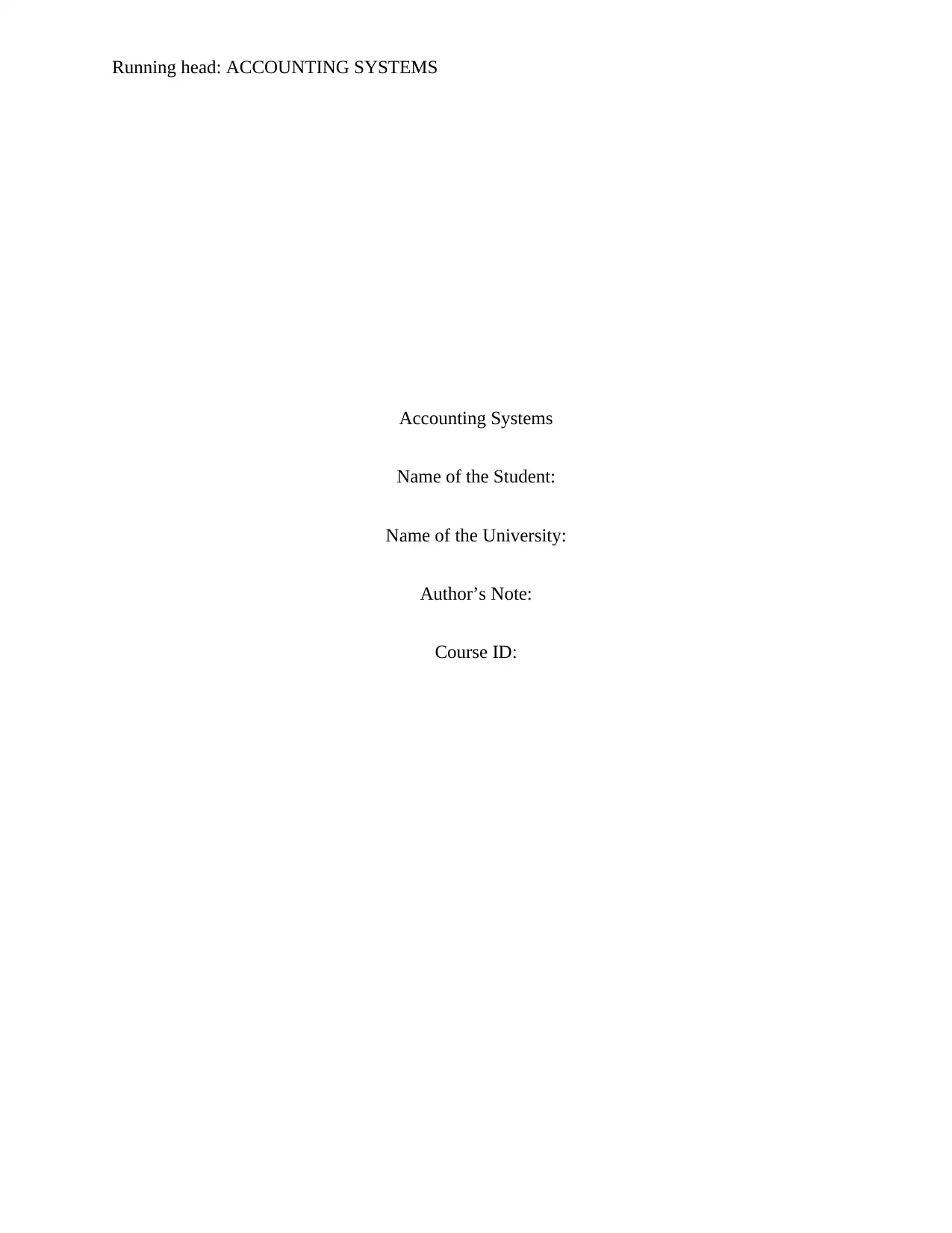
Running head: ACCOUNTING SYSTEMS
Accounting Systems
Name of the Student:
Name of the University:
Author’s Note:
Course ID:
Accounting Systems
Name of the Student:
Name of the University:
Author’s Note:
Course ID:
Paraphrase This Document
Need a fresh take? Get an instant paraphrase of this document with our AI Paraphraser
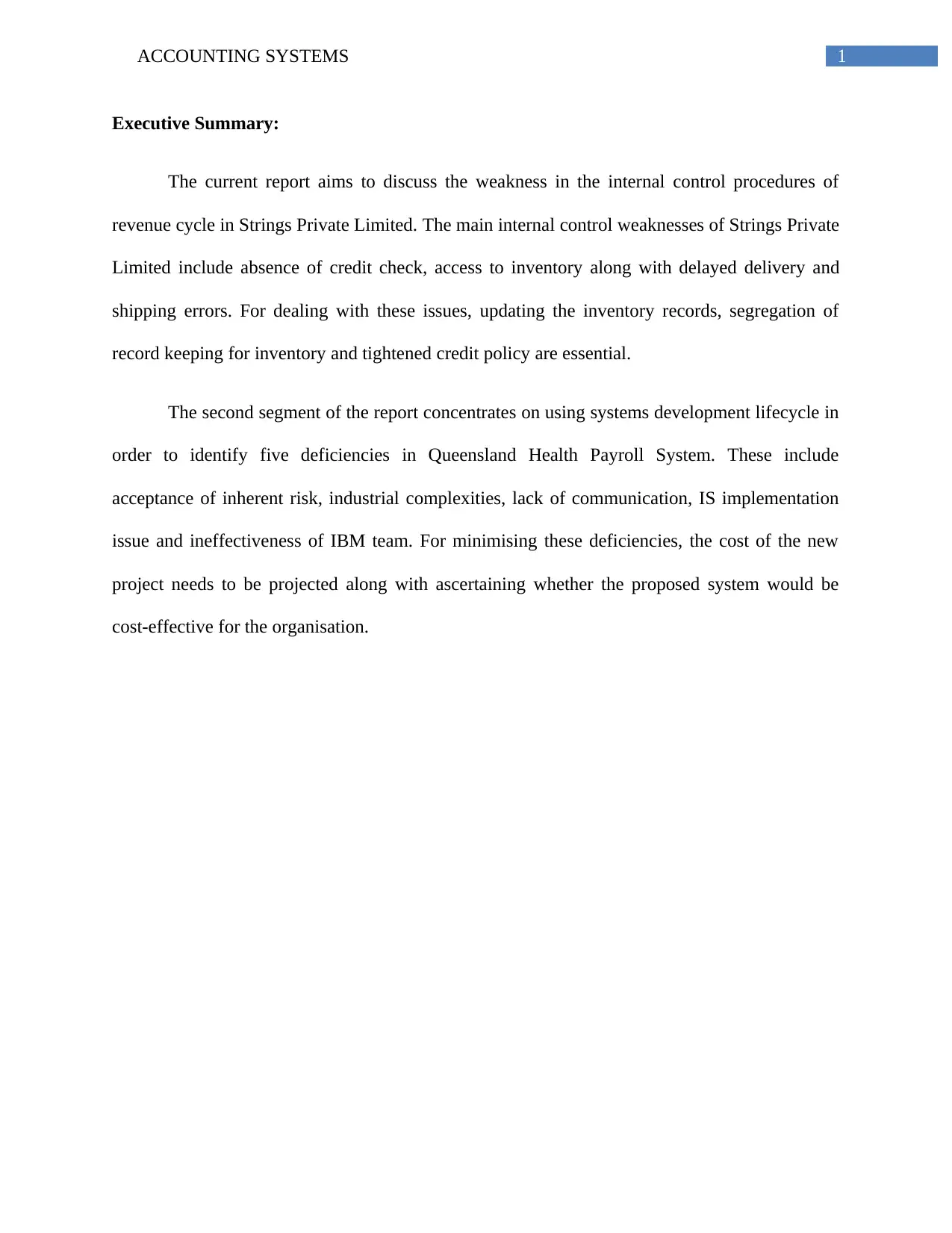
1ACCOUNTING SYSTEMS
Executive Summary:
The current report aims to discuss the weakness in the internal control procedures of
revenue cycle in Strings Private Limited. The main internal control weaknesses of Strings Private
Limited include absence of credit check, access to inventory along with delayed delivery and
shipping errors. For dealing with these issues, updating the inventory records, segregation of
record keeping for inventory and tightened credit policy are essential.
The second segment of the report concentrates on using systems development lifecycle in
order to identify five deficiencies in Queensland Health Payroll System. These include
acceptance of inherent risk, industrial complexities, lack of communication, IS implementation
issue and ineffectiveness of IBM team. For minimising these deficiencies, the cost of the new
project needs to be projected along with ascertaining whether the proposed system would be
cost-effective for the organisation.
Executive Summary:
The current report aims to discuss the weakness in the internal control procedures of
revenue cycle in Strings Private Limited. The main internal control weaknesses of Strings Private
Limited include absence of credit check, access to inventory along with delayed delivery and
shipping errors. For dealing with these issues, updating the inventory records, segregation of
record keeping for inventory and tightened credit policy are essential.
The second segment of the report concentrates on using systems development lifecycle in
order to identify five deficiencies in Queensland Health Payroll System. These include
acceptance of inherent risk, industrial complexities, lack of communication, IS implementation
issue and ineffectiveness of IBM team. For minimising these deficiencies, the cost of the new
project needs to be projected along with ascertaining whether the proposed system would be
cost-effective for the organisation.
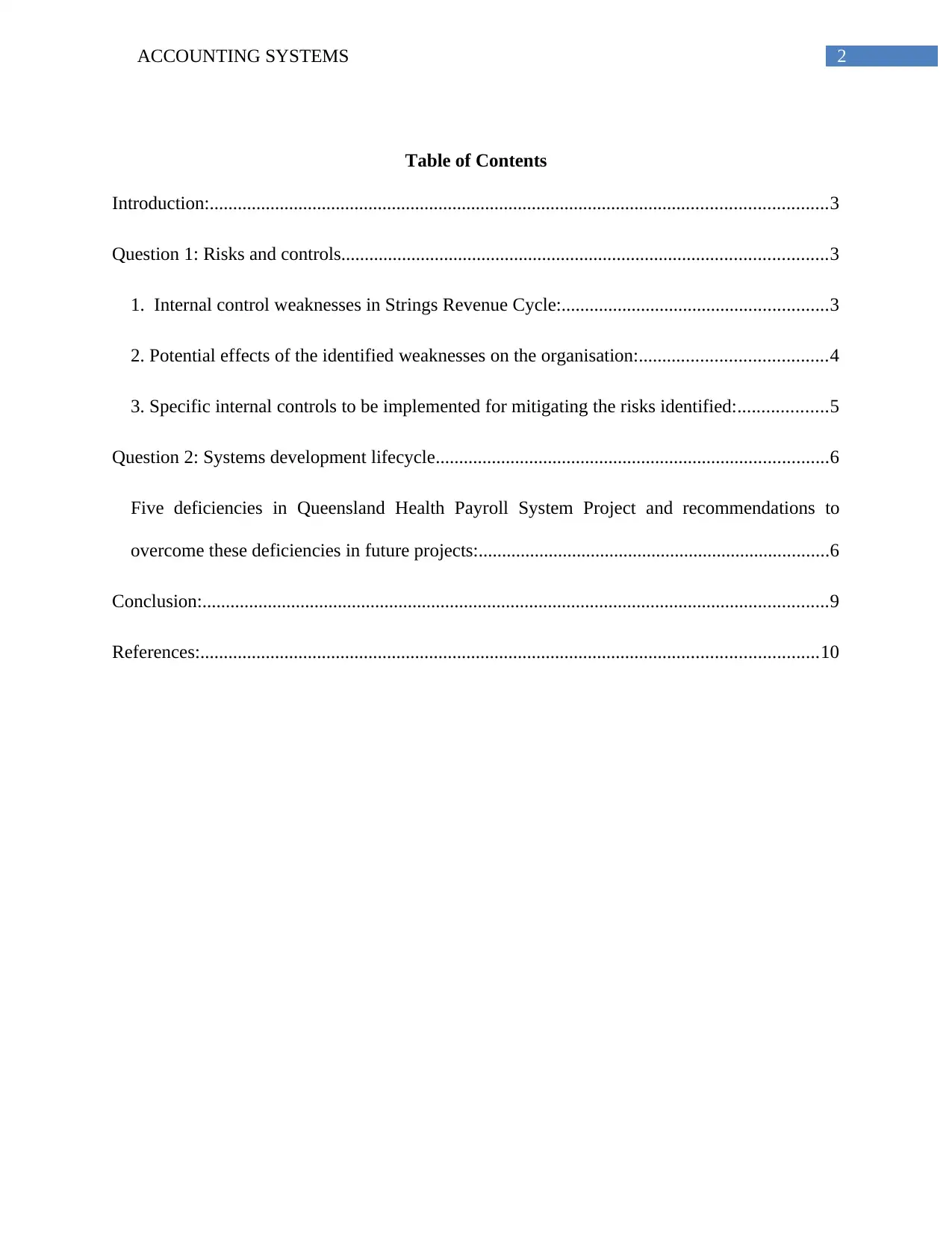
2ACCOUNTING SYSTEMS
Table of Contents
Introduction:....................................................................................................................................3
Question 1: Risks and controls........................................................................................................3
1. Internal control weaknesses in Strings Revenue Cycle:.........................................................3
2. Potential effects of the identified weaknesses on the organisation:........................................4
3. Specific internal controls to be implemented for mitigating the risks identified:...................5
Question 2: Systems development lifecycle....................................................................................6
Five deficiencies in Queensland Health Payroll System Project and recommendations to
overcome these deficiencies in future projects:...........................................................................6
Conclusion:......................................................................................................................................9
References:....................................................................................................................................10
Table of Contents
Introduction:....................................................................................................................................3
Question 1: Risks and controls........................................................................................................3
1. Internal control weaknesses in Strings Revenue Cycle:.........................................................3
2. Potential effects of the identified weaknesses on the organisation:........................................4
3. Specific internal controls to be implemented for mitigating the risks identified:...................5
Question 2: Systems development lifecycle....................................................................................6
Five deficiencies in Queensland Health Payroll System Project and recommendations to
overcome these deficiencies in future projects:...........................................................................6
Conclusion:......................................................................................................................................9
References:....................................................................................................................................10
⊘ This is a preview!⊘
Do you want full access?
Subscribe today to unlock all pages.

Trusted by 1+ million students worldwide
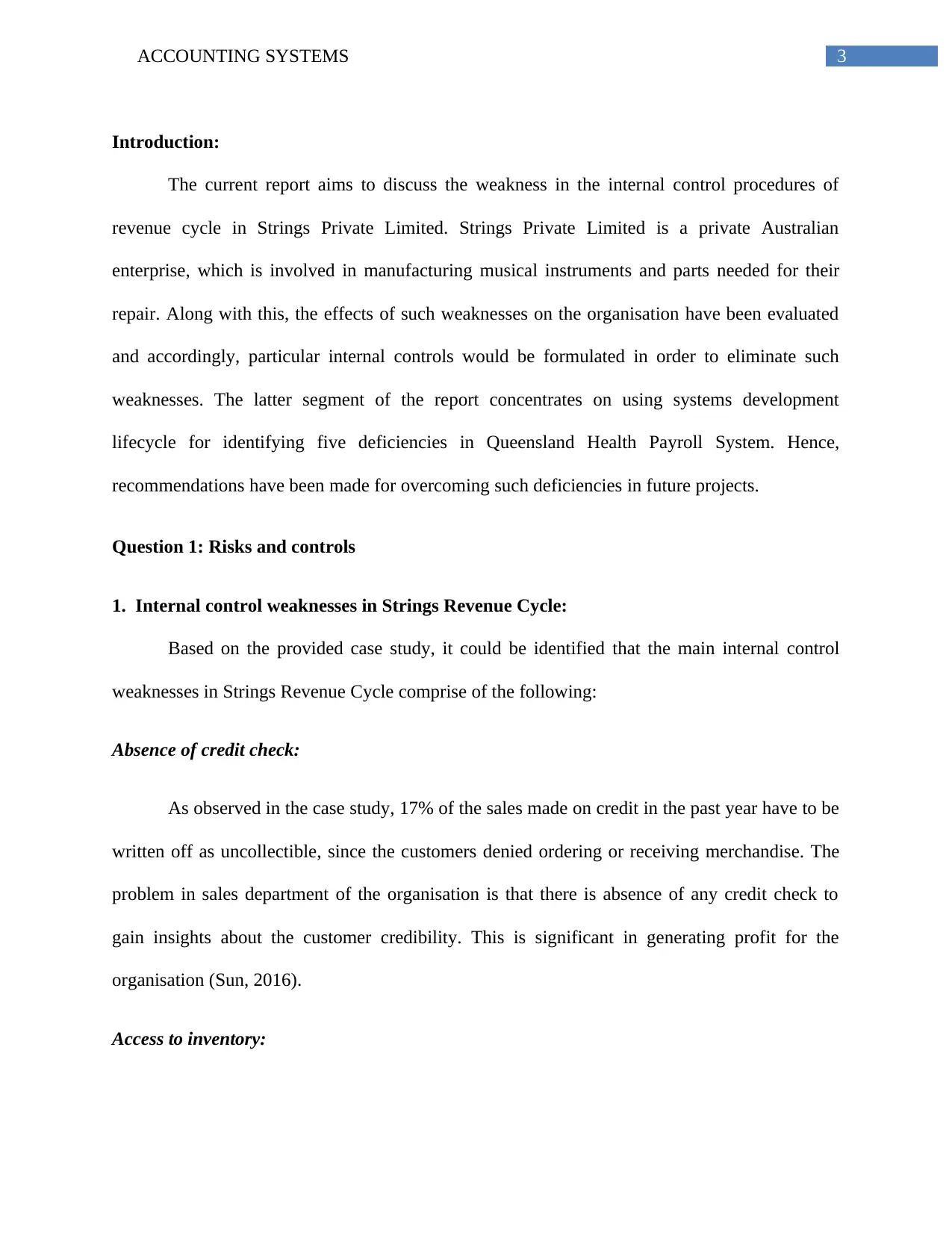
3ACCOUNTING SYSTEMS
Introduction:
The current report aims to discuss the weakness in the internal control procedures of
revenue cycle in Strings Private Limited. Strings Private Limited is a private Australian
enterprise, which is involved in manufacturing musical instruments and parts needed for their
repair. Along with this, the effects of such weaknesses on the organisation have been evaluated
and accordingly, particular internal controls would be formulated in order to eliminate such
weaknesses. The latter segment of the report concentrates on using systems development
lifecycle for identifying five deficiencies in Queensland Health Payroll System. Hence,
recommendations have been made for overcoming such deficiencies in future projects.
Question 1: Risks and controls
1. Internal control weaknesses in Strings Revenue Cycle:
Based on the provided case study, it could be identified that the main internal control
weaknesses in Strings Revenue Cycle comprise of the following:
Absence of credit check:
As observed in the case study, 17% of the sales made on credit in the past year have to be
written off as uncollectible, since the customers denied ordering or receiving merchandise. The
problem in sales department of the organisation is that there is absence of any credit check to
gain insights about the customer credibility. This is significant in generating profit for the
organisation (Sun, 2016).
Access to inventory:
Introduction:
The current report aims to discuss the weakness in the internal control procedures of
revenue cycle in Strings Private Limited. Strings Private Limited is a private Australian
enterprise, which is involved in manufacturing musical instruments and parts needed for their
repair. Along with this, the effects of such weaknesses on the organisation have been evaluated
and accordingly, particular internal controls would be formulated in order to eliminate such
weaknesses. The latter segment of the report concentrates on using systems development
lifecycle for identifying five deficiencies in Queensland Health Payroll System. Hence,
recommendations have been made for overcoming such deficiencies in future projects.
Question 1: Risks and controls
1. Internal control weaknesses in Strings Revenue Cycle:
Based on the provided case study, it could be identified that the main internal control
weaknesses in Strings Revenue Cycle comprise of the following:
Absence of credit check:
As observed in the case study, 17% of the sales made on credit in the past year have to be
written off as uncollectible, since the customers denied ordering or receiving merchandise. The
problem in sales department of the organisation is that there is absence of any credit check to
gain insights about the customer credibility. This is significant in generating profit for the
organisation (Sun, 2016).
Access to inventory:
Paraphrase This Document
Need a fresh take? Get an instant paraphrase of this document with our AI Paraphraser

4ACCOUNTING SYSTEMS
Another problem associated with the revenue cycle of Strings Private Limited is that the
warehouse staff utilises the logbook for updating the inventory records. This implies that the
warehouse clerk has access to inventory and the person could update the inventory ledger as
well, which might be inaccurate (Jacoby et al., 2017).
Delayed delivery and errors in shipping:
The case study states that the organisation has experienced increase in the overall volume
of sales this year, which have lead to large number of errors. This is because wrong items are
delivered to the customers (Newton et al., 2015). Shipping delays are observed as well, since the
items assumed to be in stock could not be found in the warehouse. Along with this, there is
absence of physical count of inventory over the past two years, even though there is maintenance
of perpetual inventory system. Thus at the time of placing the sales order, there is uncertainty
related to transaction details, which could be subject to change (Feng et al., 2014).
2. Potential effects of the identified weaknesses on the organisation:
The potential effects of the identified weaknesses on Strings Private Limited constitute of
the following:
Effect of absence of credit check:
With the help of credit check, it is possible to obtain a quick insight of the financial
position of the customers. However, this needs to be used occasionally for monitoring the credit
situation of the customers without negative effect on their credit scores (Yu, Zhang & Zheng,
2016). As Strings Private Limited could not recover 17.5% of the credit sales from the
customers, it would result in minimisation of the overall profit generated. Hence, this might
reduce the dividend payout to the shareholders and availability of working capital.
Another problem associated with the revenue cycle of Strings Private Limited is that the
warehouse staff utilises the logbook for updating the inventory records. This implies that the
warehouse clerk has access to inventory and the person could update the inventory ledger as
well, which might be inaccurate (Jacoby et al., 2017).
Delayed delivery and errors in shipping:
The case study states that the organisation has experienced increase in the overall volume
of sales this year, which have lead to large number of errors. This is because wrong items are
delivered to the customers (Newton et al., 2015). Shipping delays are observed as well, since the
items assumed to be in stock could not be found in the warehouse. Along with this, there is
absence of physical count of inventory over the past two years, even though there is maintenance
of perpetual inventory system. Thus at the time of placing the sales order, there is uncertainty
related to transaction details, which could be subject to change (Feng et al., 2014).
2. Potential effects of the identified weaknesses on the organisation:
The potential effects of the identified weaknesses on Strings Private Limited constitute of
the following:
Effect of absence of credit check:
With the help of credit check, it is possible to obtain a quick insight of the financial
position of the customers. However, this needs to be used occasionally for monitoring the credit
situation of the customers without negative effect on their credit scores (Yu, Zhang & Zheng,
2016). As Strings Private Limited could not recover 17.5% of the credit sales from the
customers, it would result in minimisation of the overall profit generated. Hence, this might
reduce the dividend payout to the shareholders and availability of working capital.
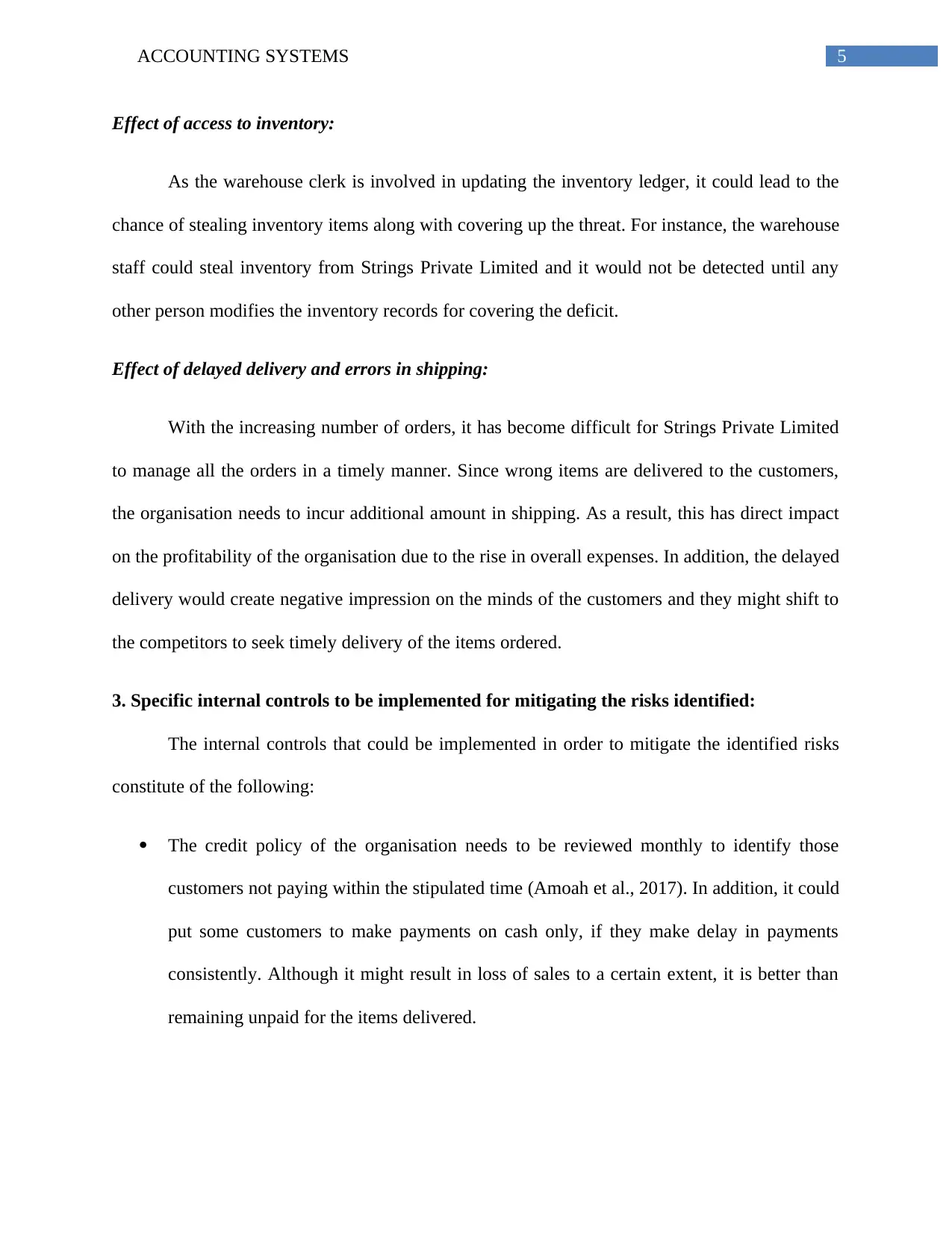
5ACCOUNTING SYSTEMS
Effect of access to inventory:
As the warehouse clerk is involved in updating the inventory ledger, it could lead to the
chance of stealing inventory items along with covering up the threat. For instance, the warehouse
staff could steal inventory from Strings Private Limited and it would not be detected until any
other person modifies the inventory records for covering the deficit.
Effect of delayed delivery and errors in shipping:
With the increasing number of orders, it has become difficult for Strings Private Limited
to manage all the orders in a timely manner. Since wrong items are delivered to the customers,
the organisation needs to incur additional amount in shipping. As a result, this has direct impact
on the profitability of the organisation due to the rise in overall expenses. In addition, the delayed
delivery would create negative impression on the minds of the customers and they might shift to
the competitors to seek timely delivery of the items ordered.
3. Specific internal controls to be implemented for mitigating the risks identified:
The internal controls that could be implemented in order to mitigate the identified risks
constitute of the following:
The credit policy of the organisation needs to be reviewed monthly to identify those
customers not paying within the stipulated time (Amoah et al., 2017). In addition, it could
put some customers to make payments on cash only, if they make delay in payments
consistently. Although it might result in loss of sales to a certain extent, it is better than
remaining unpaid for the items delivered.
Effect of access to inventory:
As the warehouse clerk is involved in updating the inventory ledger, it could lead to the
chance of stealing inventory items along with covering up the threat. For instance, the warehouse
staff could steal inventory from Strings Private Limited and it would not be detected until any
other person modifies the inventory records for covering the deficit.
Effect of delayed delivery and errors in shipping:
With the increasing number of orders, it has become difficult for Strings Private Limited
to manage all the orders in a timely manner. Since wrong items are delivered to the customers,
the organisation needs to incur additional amount in shipping. As a result, this has direct impact
on the profitability of the organisation due to the rise in overall expenses. In addition, the delayed
delivery would create negative impression on the minds of the customers and they might shift to
the competitors to seek timely delivery of the items ordered.
3. Specific internal controls to be implemented for mitigating the risks identified:
The internal controls that could be implemented in order to mitigate the identified risks
constitute of the following:
The credit policy of the organisation needs to be reviewed monthly to identify those
customers not paying within the stipulated time (Amoah et al., 2017). In addition, it could
put some customers to make payments on cash only, if they make delay in payments
consistently. Although it might result in loss of sales to a certain extent, it is better than
remaining unpaid for the items delivered.
⊘ This is a preview!⊘
Do you want full access?
Subscribe today to unlock all pages.

Trusted by 1+ million students worldwide
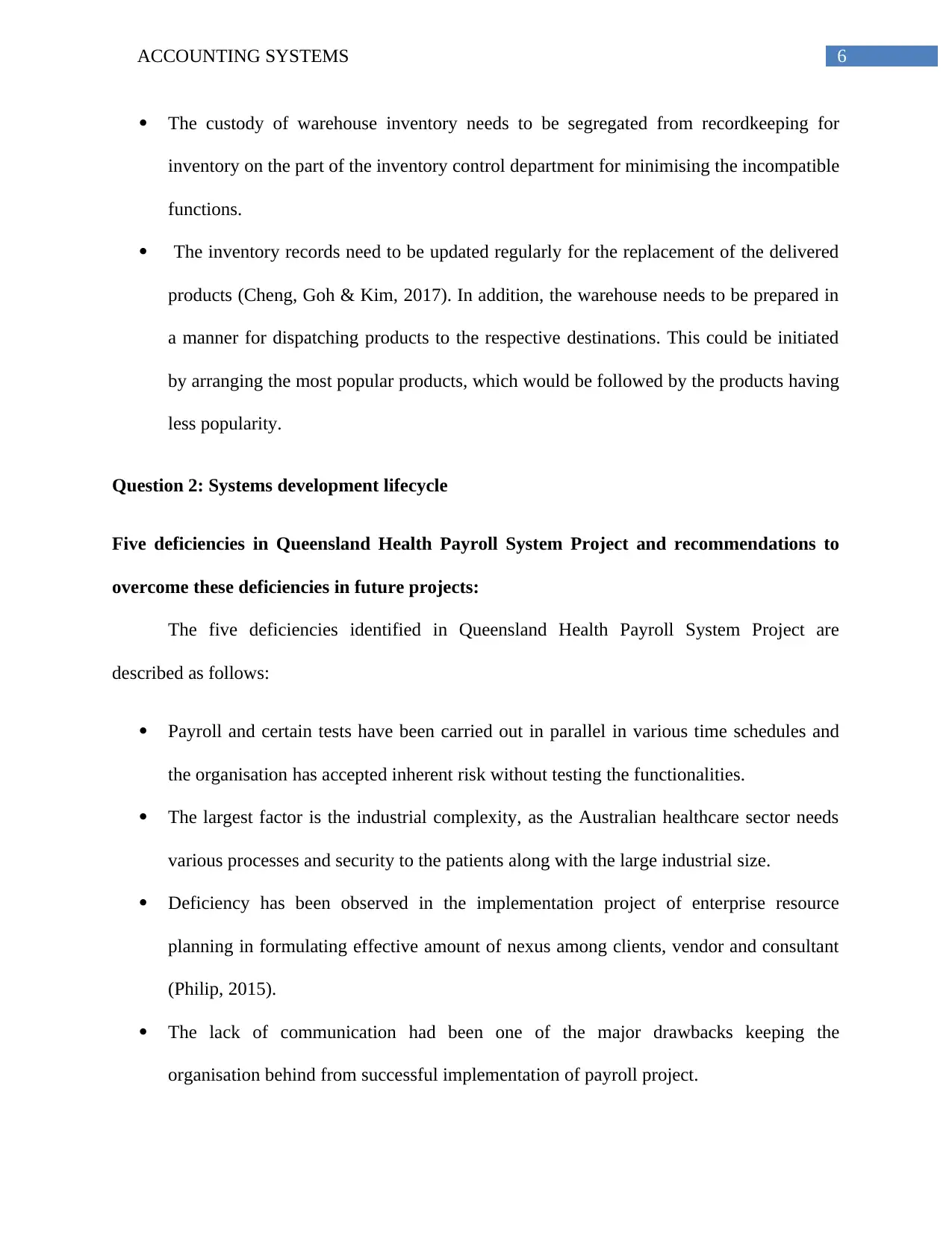
6ACCOUNTING SYSTEMS
The custody of warehouse inventory needs to be segregated from recordkeeping for
inventory on the part of the inventory control department for minimising the incompatible
functions.
The inventory records need to be updated regularly for the replacement of the delivered
products (Cheng, Goh & Kim, 2017). In addition, the warehouse needs to be prepared in
a manner for dispatching products to the respective destinations. This could be initiated
by arranging the most popular products, which would be followed by the products having
less popularity.
Question 2: Systems development lifecycle
Five deficiencies in Queensland Health Payroll System Project and recommendations to
overcome these deficiencies in future projects:
The five deficiencies identified in Queensland Health Payroll System Project are
described as follows:
Payroll and certain tests have been carried out in parallel in various time schedules and
the organisation has accepted inherent risk without testing the functionalities.
The largest factor is the industrial complexity, as the Australian healthcare sector needs
various processes and security to the patients along with the large industrial size.
Deficiency has been observed in the implementation project of enterprise resource
planning in formulating effective amount of nexus among clients, vendor and consultant
(Philip, 2015).
The lack of communication had been one of the major drawbacks keeping the
organisation behind from successful implementation of payroll project.
The custody of warehouse inventory needs to be segregated from recordkeeping for
inventory on the part of the inventory control department for minimising the incompatible
functions.
The inventory records need to be updated regularly for the replacement of the delivered
products (Cheng, Goh & Kim, 2017). In addition, the warehouse needs to be prepared in
a manner for dispatching products to the respective destinations. This could be initiated
by arranging the most popular products, which would be followed by the products having
less popularity.
Question 2: Systems development lifecycle
Five deficiencies in Queensland Health Payroll System Project and recommendations to
overcome these deficiencies in future projects:
The five deficiencies identified in Queensland Health Payroll System Project are
described as follows:
Payroll and certain tests have been carried out in parallel in various time schedules and
the organisation has accepted inherent risk without testing the functionalities.
The largest factor is the industrial complexity, as the Australian healthcare sector needs
various processes and security to the patients along with the large industrial size.
Deficiency has been observed in the implementation project of enterprise resource
planning in formulating effective amount of nexus among clients, vendor and consultant
(Philip, 2015).
The lack of communication had been one of the major drawbacks keeping the
organisation behind from successful implementation of payroll project.
Paraphrase This Document
Need a fresh take? Get an instant paraphrase of this document with our AI Paraphraser
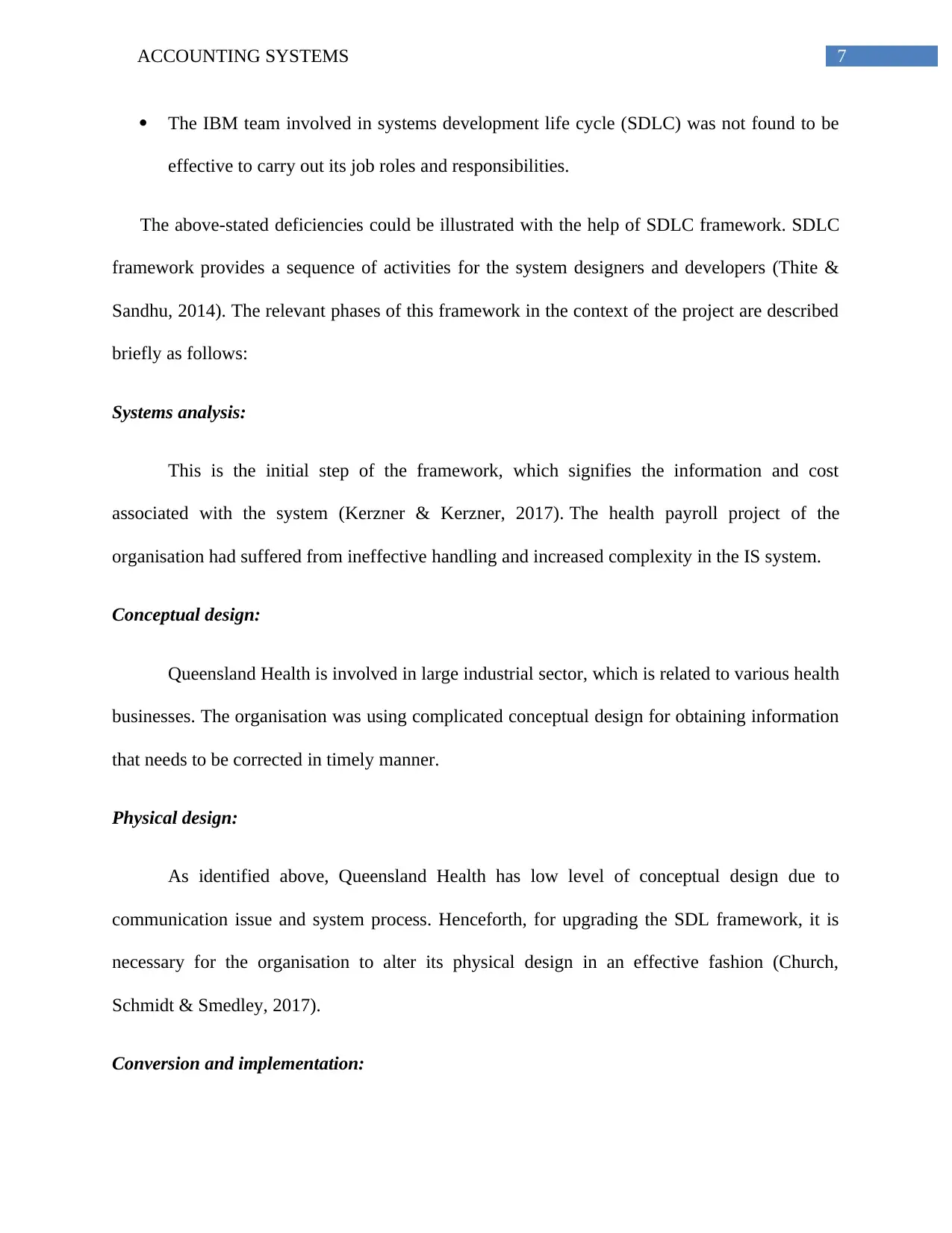
7ACCOUNTING SYSTEMS
The IBM team involved in systems development life cycle (SDLC) was not found to be
effective to carry out its job roles and responsibilities.
The above-stated deficiencies could be illustrated with the help of SDLC framework. SDLC
framework provides a sequence of activities for the system designers and developers (Thite &
Sandhu, 2014). The relevant phases of this framework in the context of the project are described
briefly as follows:
Systems analysis:
This is the initial step of the framework, which signifies the information and cost
associated with the system (Kerzner & Kerzner, 2017). The health payroll project of the
organisation had suffered from ineffective handling and increased complexity in the IS system.
Conceptual design:
Queensland Health is involved in large industrial sector, which is related to various health
businesses. The organisation was using complicated conceptual design for obtaining information
that needs to be corrected in timely manner.
Physical design:
As identified above, Queensland Health has low level of conceptual design due to
communication issue and system process. Henceforth, for upgrading the SDL framework, it is
necessary for the organisation to alter its physical design in an effective fashion (Church,
Schmidt & Smedley, 2017).
Conversion and implementation:
The IBM team involved in systems development life cycle (SDLC) was not found to be
effective to carry out its job roles and responsibilities.
The above-stated deficiencies could be illustrated with the help of SDLC framework. SDLC
framework provides a sequence of activities for the system designers and developers (Thite &
Sandhu, 2014). The relevant phases of this framework in the context of the project are described
briefly as follows:
Systems analysis:
This is the initial step of the framework, which signifies the information and cost
associated with the system (Kerzner & Kerzner, 2017). The health payroll project of the
organisation had suffered from ineffective handling and increased complexity in the IS system.
Conceptual design:
Queensland Health is involved in large industrial sector, which is related to various health
businesses. The organisation was using complicated conceptual design for obtaining information
that needs to be corrected in timely manner.
Physical design:
As identified above, Queensland Health has low level of conceptual design due to
communication issue and system process. Henceforth, for upgrading the SDL framework, it is
necessary for the organisation to alter its physical design in an effective fashion (Church,
Schmidt & Smedley, 2017).
Conversion and implementation:
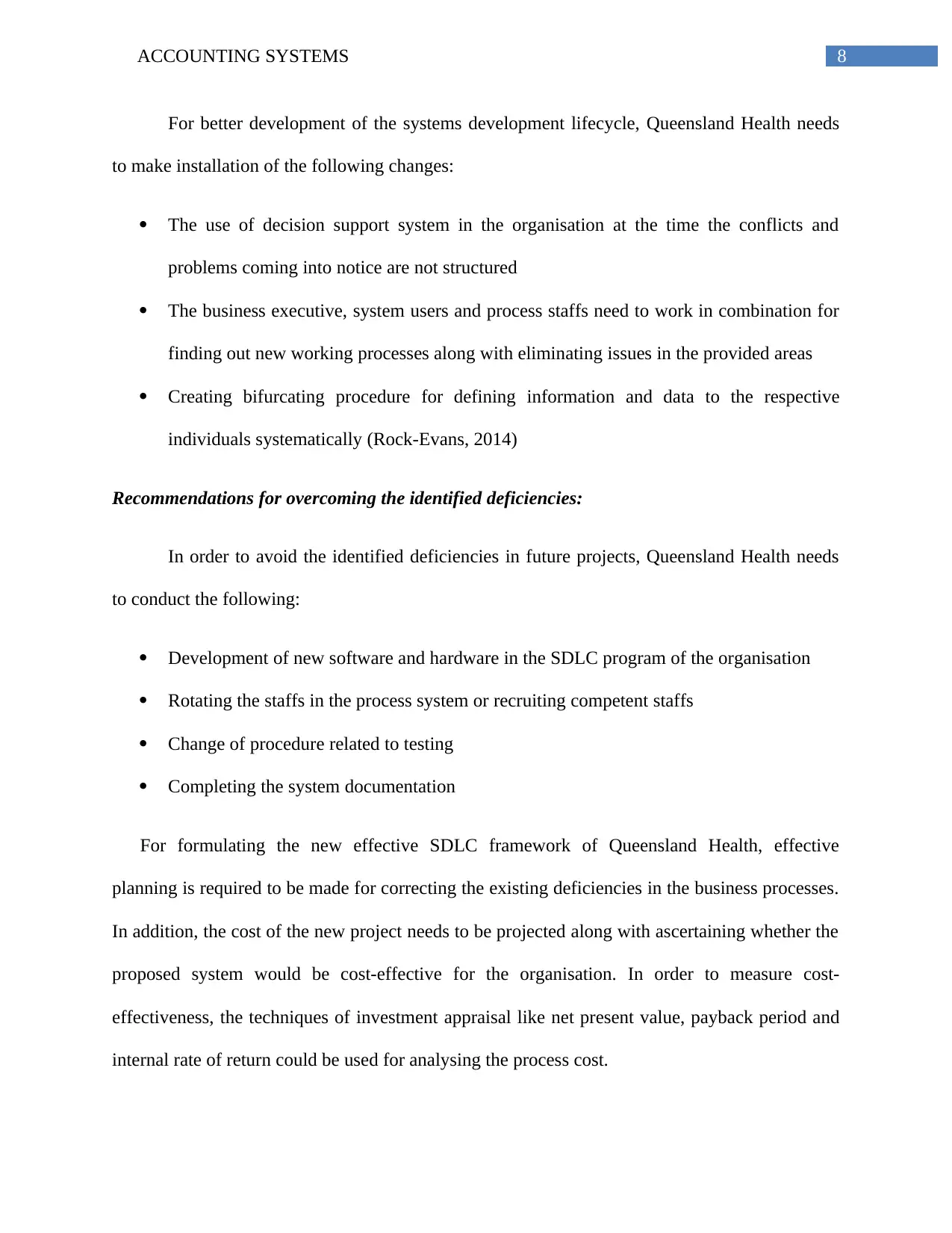
8ACCOUNTING SYSTEMS
For better development of the systems development lifecycle, Queensland Health needs
to make installation of the following changes:
The use of decision support system in the organisation at the time the conflicts and
problems coming into notice are not structured
The business executive, system users and process staffs need to work in combination for
finding out new working processes along with eliminating issues in the provided areas
Creating bifurcating procedure for defining information and data to the respective
individuals systematically (Rock-Evans, 2014)
Recommendations for overcoming the identified deficiencies:
In order to avoid the identified deficiencies in future projects, Queensland Health needs
to conduct the following:
Development of new software and hardware in the SDLC program of the organisation
Rotating the staffs in the process system or recruiting competent staffs
Change of procedure related to testing
Completing the system documentation
For formulating the new effective SDLC framework of Queensland Health, effective
planning is required to be made for correcting the existing deficiencies in the business processes.
In addition, the cost of the new project needs to be projected along with ascertaining whether the
proposed system would be cost-effective for the organisation. In order to measure cost-
effectiveness, the techniques of investment appraisal like net present value, payback period and
internal rate of return could be used for analysing the process cost.
For better development of the systems development lifecycle, Queensland Health needs
to make installation of the following changes:
The use of decision support system in the organisation at the time the conflicts and
problems coming into notice are not structured
The business executive, system users and process staffs need to work in combination for
finding out new working processes along with eliminating issues in the provided areas
Creating bifurcating procedure for defining information and data to the respective
individuals systematically (Rock-Evans, 2014)
Recommendations for overcoming the identified deficiencies:
In order to avoid the identified deficiencies in future projects, Queensland Health needs
to conduct the following:
Development of new software and hardware in the SDLC program of the organisation
Rotating the staffs in the process system or recruiting competent staffs
Change of procedure related to testing
Completing the system documentation
For formulating the new effective SDLC framework of Queensland Health, effective
planning is required to be made for correcting the existing deficiencies in the business processes.
In addition, the cost of the new project needs to be projected along with ascertaining whether the
proposed system would be cost-effective for the organisation. In order to measure cost-
effectiveness, the techniques of investment appraisal like net present value, payback period and
internal rate of return could be used for analysing the process cost.
⊘ This is a preview!⊘
Do you want full access?
Subscribe today to unlock all pages.

Trusted by 1+ million students worldwide
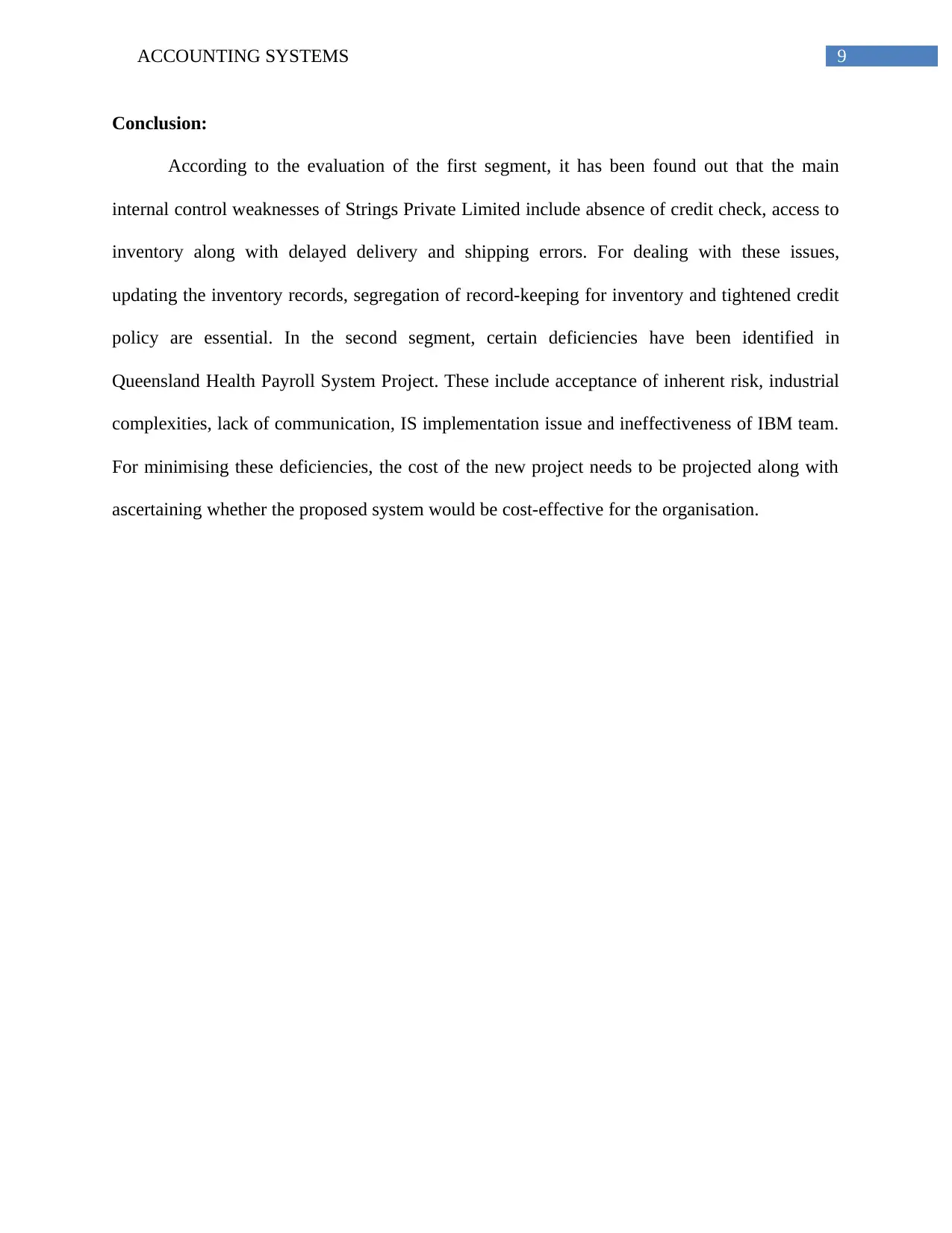
9ACCOUNTING SYSTEMS
Conclusion:
According to the evaluation of the first segment, it has been found out that the main
internal control weaknesses of Strings Private Limited include absence of credit check, access to
inventory along with delayed delivery and shipping errors. For dealing with these issues,
updating the inventory records, segregation of record-keeping for inventory and tightened credit
policy are essential. In the second segment, certain deficiencies have been identified in
Queensland Health Payroll System Project. These include acceptance of inherent risk, industrial
complexities, lack of communication, IS implementation issue and ineffectiveness of IBM team.
For minimising these deficiencies, the cost of the new project needs to be projected along with
ascertaining whether the proposed system would be cost-effective for the organisation.
Conclusion:
According to the evaluation of the first segment, it has been found out that the main
internal control weaknesses of Strings Private Limited include absence of credit check, access to
inventory along with delayed delivery and shipping errors. For dealing with these issues,
updating the inventory records, segregation of record-keeping for inventory and tightened credit
policy are essential. In the second segment, certain deficiencies have been identified in
Queensland Health Payroll System Project. These include acceptance of inherent risk, industrial
complexities, lack of communication, IS implementation issue and ineffectiveness of IBM team.
For minimising these deficiencies, the cost of the new project needs to be projected along with
ascertaining whether the proposed system would be cost-effective for the organisation.
Paraphrase This Document
Need a fresh take? Get an instant paraphrase of this document with our AI Paraphraser

10ACCOUNTING SYSTEMS
References:
Amoah, N. Y., Anderson, A., Bonaparte, I., & Tang, A. P. (2017). Internal Control Material
Weakness and Real Earnings Management. In Parables, Myths and Risks (pp. 1-21).
Emerald Publishing Limited.
Cheng, Q., Goh, B. W., & Kim, J. B. (2017). Internal control and operational efficiency.
Church, K. S., Schmidt, P. J., & Smedley, G. (2017). Casey's Collections: A Strategic Decision-
Making Case Using the Systems Development Lifecycle—Planning and Analysis
Phases. Journal of Emerging Technologies in Accounting Teaching Notes, 13(2), 31-81.
Feng, M., Li, C., McVay, S. E., & Skaife, H. (2014). Does ineffective internal control over
financial reporting affect a firm's operations? Evidence from firms' inventory
management. The Accounting Review, 90(2), 529-557.
Jacoby, G., Li, Y., Li, T., & Zheng, S. X. (2017). Internal control weakness, investment and firm
valuation. Finance Research Letters.
Kerzner, H., & Kerzner, H. R. (2017). Project management: a systems approach to planning,
scheduling, and controlling. John Wiley & Sons.
Newton, N. J., Persellin, J. S., Wang, D., & Wilkins, M. S. (2015). Internal control opinion
shopping and audit market competition. The Accounting Review, 91(2), 603-623.
Philip, K. (2015). Allied health: untapped potential in the Australian health system. Australian
Health Review, 39(3), 244-247.
References:
Amoah, N. Y., Anderson, A., Bonaparte, I., & Tang, A. P. (2017). Internal Control Material
Weakness and Real Earnings Management. In Parables, Myths and Risks (pp. 1-21).
Emerald Publishing Limited.
Cheng, Q., Goh, B. W., & Kim, J. B. (2017). Internal control and operational efficiency.
Church, K. S., Schmidt, P. J., & Smedley, G. (2017). Casey's Collections: A Strategic Decision-
Making Case Using the Systems Development Lifecycle—Planning and Analysis
Phases. Journal of Emerging Technologies in Accounting Teaching Notes, 13(2), 31-81.
Feng, M., Li, C., McVay, S. E., & Skaife, H. (2014). Does ineffective internal control over
financial reporting affect a firm's operations? Evidence from firms' inventory
management. The Accounting Review, 90(2), 529-557.
Jacoby, G., Li, Y., Li, T., & Zheng, S. X. (2017). Internal control weakness, investment and firm
valuation. Finance Research Letters.
Kerzner, H., & Kerzner, H. R. (2017). Project management: a systems approach to planning,
scheduling, and controlling. John Wiley & Sons.
Newton, N. J., Persellin, J. S., Wang, D., & Wilkins, M. S. (2015). Internal control opinion
shopping and audit market competition. The Accounting Review, 91(2), 603-623.
Philip, K. (2015). Allied health: untapped potential in the Australian health system. Australian
Health Review, 39(3), 244-247.

11ACCOUNTING SYSTEMS
Rock-Evans, R. (2014). Analysis within the Systems Development Life-Cycle: Book 4 Activity
Analysis—The Methods. Elsevier.
Sun, Y. (2016). Internal control weakness disclosure and firm investment. Journal of
Accounting, Auditing & Finance, 31(2), 277-307.
Thite, M., & Sandhu, K. (2014). Where is My Pay? Critical Success Factors of a Payroll
System–A System Life Cycle Approach. Australasian Journal of Information
Systems, 18(2).
Yu, J., Zhang, Z., & Zheng, S. X. (2016). The effect of internal control weakness on firm
valuation: Evidence from SOX Section 404 disclosuresAuthor-Name: Li,
Yingqi. Finance Research Letters, 17(C), 17-24.
Rock-Evans, R. (2014). Analysis within the Systems Development Life-Cycle: Book 4 Activity
Analysis—The Methods. Elsevier.
Sun, Y. (2016). Internal control weakness disclosure and firm investment. Journal of
Accounting, Auditing & Finance, 31(2), 277-307.
Thite, M., & Sandhu, K. (2014). Where is My Pay? Critical Success Factors of a Payroll
System–A System Life Cycle Approach. Australasian Journal of Information
Systems, 18(2).
Yu, J., Zhang, Z., & Zheng, S. X. (2016). The effect of internal control weakness on firm
valuation: Evidence from SOX Section 404 disclosuresAuthor-Name: Li,
Yingqi. Finance Research Letters, 17(C), 17-24.
⊘ This is a preview!⊘
Do you want full access?
Subscribe today to unlock all pages.

Trusted by 1+ million students worldwide
1 out of 12
Related Documents
Your All-in-One AI-Powered Toolkit for Academic Success.
+13062052269
info@desklib.com
Available 24*7 on WhatsApp / Email
![[object Object]](/_next/static/media/star-bottom.7253800d.svg)
Unlock your academic potential
Copyright © 2020–2025 A2Z Services. All Rights Reserved. Developed and managed by ZUCOL.





